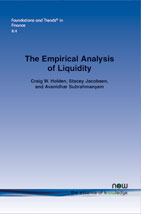The Empirical Analysis of Liquidity
By Craig W. Holden, Kelley School of Business, Indiana University, USA, cholden@indiana.edu | Stacey Jacobsen, Cox School of Business, Southern Methodist University, USA, staceyj@cox.smu.edu | Avanidhar Subrahmanyam, Anderson School of Management, University of California, USA, subra@anderson.ucla.edu
Abstract
We provide a synthesis of the empirical evidence on market liquidity. The liquidity measurement literature has established standard measures of liquidity that apply to broad categories of market microstructure data. Specialized measures of liquidity have been developed to deal with data limitations in specific markets, to provide proxies from daily data, and to assess institutional trading programs. The general liquidity literature has established local cross-sectional patterns, global cross-sectional patterns, and time-series patterns. Commonality in liquidity is prevalent. Certain exchange designs enhance market liquidity: a limit order book for high volume markets, a hybrid exchange for low volume markets, and multiple competing exchanges. Automatic execution increases speed, but increases spreads. A tick size reduction yields a large improvement in liquidity. Providing ex-post transparency to an otherwise opaque market dramatically improves liquidity. Opening up the limit order book improves liquidity. Regulatory reforms that increase the number of competitive alternatives, move toward linking them up, and level the playing field between exchanges improves liquidity. High-frequency traders trade in both a passive, liquidity-supplying manner and an aggressive, liquidity-demanding manner. Their overall impact improves both liquidity and price efficiency, but concerns remain regarding occasional trading glitches, order anticipation strategies, and latency arbitrage at the expense of slow traders. The liquidity and corporate finance literature provides abundant evidence that liquidity is beneficial in many corporate settings: liquidity increases the power of governance via exit, reduces the cost of governance via intervention, facilitates the entrance of informed traders who produce valuable information about the firm, enhances the effectiveness of equity-based compensation to managers, reduces the cost of equity financing, mitigates trading frictions investors encounter when trading in the market to recreate a preferred payout policy, and lowers the immediate transaction costs and subsequent liquidity costs for firms conducting large share repurchases. Further, the influence goes both ways. There is evidence that firms influence their own liquidity through a broad range of corporate decisions including internal governance standards, equity issuance form and pricing, share repurchases, acquisition targets, and disclosure timeliness and quality. The literature on liquidity and asset pricing demonstrates that both average liquidity cost and liquidity risk are priced, liquidity enhances market efficiency, and liquidity strengthens the arbitrage linkage between related markets. We conclude with directions for future research.
The Empirical Analysis of Liquidity
The Empirical Analysis of Liquidity starts with an overview of how liquidity is measured and specialized issues in liquidity measurement. Next, it examines what is known about cross-sectional and timeseries patterns in liquidity. The authors then review how liquidity relates to the corporate finance literature, including governance, executive compensation, capital structure, and payout policy. They also review how liquidity influences the asset pricing literature, including return differentials due to average liquidity cost, liquidity premia for systematic liquidity risks, the impact of liquidity on market efficiency, and the impact of liquidity on the law of one price. Finally, some open questions and opportunities for future research are discussed.
The Empirical Analysis of Liquidity is organized as follows. Section 2 considers the approaches taken to measure liquidity. Section 3 considers cross-sectional and time-series patterns in liquidity, commonality it liquidity, the impact of exchange design, the impact of exogenous policy shifts on liquidity, and the impact of high-frequency traders. Section 4 analyzes the relation between liquidity and corporate financial decisions. Section 5 explores the impact of liquidity on asset pricing, and Section 6 concludes with directions for future research.
